| |
| |
Last update: 02/12/2008
Thanks to Christophe Simoncelli for their photos.
Hibernation (winter
sleep) : is the state of dormancy in which some animals spend the
winter in colder latitudes. (typically October through April in
the Northern Hemisphere).
The estivation
(Summer sleep ) : an other state of dormancy in which like other
species snails spend periods of heat or drought in warmer latitudes.
1
- estivation:
The
snail lives short periods of great activity, which are essential for
building up its reserves. These allow him a slowed down long term
life.
Mais l'activité provoque l'usure et le vieillissement
tandis que la vie ralentie apporte un repos réparateur. Activity
causes wear and aging while slowed life brings a refreshing rest.
The snail's rest periods frequent and regular assure a relatively long life.
The snail sleeps in summer during digesting, or pending the favourable weather to eat.
Drought
and heat cause sleep therefore long-term (no feeding), while the daily
sleep is the need for rest successive after a great activity.
2
- The hibernation: adapt or ..... Perish!
Winter is a long rest period, the prolonged fasting. Snails must
deal this with a maximum of reserve because it can take rest 4 to 6
months. They will come into hibernation when the temperature
falls under 12 at 15 ° C.
| In many ectotherm animals , ie unable
to regulate their temperature, winter also corresponds to an entry in
life slowed. From October to March, helix aspersa seal its shell by an
operculum (épiphragm) and stops feeding. His oxygen consumption
decrease from 0035 cm3/g/h in activity to 0,014 cm3/g/h during
hibernation. This decline in consumption is explained not only by the
immobility of the animal, since at rest, during the summer, it is 0026
cm3/g/h. The reason is a slowdown of the vital functions : the
heartbeat spend from 100 per minute at 38 ° C, to 1 per minute
below 0 ° C. The metabolism, among ectotherm as escargot, depends
on temperature : a minimum temperature is crucial for the functioning
of enzymes necessary for any biochemical reaction. Many ectothermes
(lombric, frog, snake ,...), therefore burrow in the ground or in a
cavity, numb with cold, and can become active in a timely warming. | 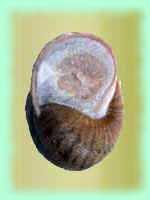 |
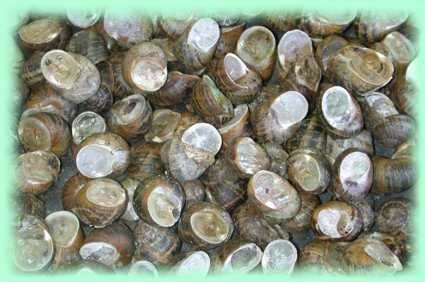 |
| Herewith, a defense thesis: Hibernation and cold resistance at the snail squirrel Helix aspersa Müller (Gastéropode, Pulmoné)
By Armelle ANSART
In
Britain, terrestrial snail Helix aspersa Müller
(Gastéropod, Pulmoné) enters into hibernation around
October, under the combined action of the decreasing day
length (from 16 to 12 hr depresses significantly mean
supercooling points (SCP) and water content of Helix aspersa
Müller ) and low temperatures. With a limited capacity of cooling
and survival limited to the freezing of is tissues, H. Aspersa can be
seen as an animal "partially freezing tolerance." During the
winter, its survival at temperatures negative is improved mainly by the
occupation of boxes of hibernation and the moderate expansion of its
capacity for cooling. It is caused by a set of characteristics specific
of the animal and the process of achieving dormant : the decline
of the water causes the concentration of solutes and less likely
nucleation, the formation of an epiphragm , coupled with the presence
of the shell, is a barrier against freezing, fasting due to the
cessation of the activity involves the evacuation of nucleants agents
in the digestive tract. Meanwhile, the relatively large size of this
species, its particular shape and the presence of the shell, it has a
certain ability to withstand the freezing of tissues. If this
capability does not seem to have adaptive value in the learning
environment, where temperatures rarely descend below the
crystallization temperature of snails, it could prove essential for
animals subjected to a cold environment. The interim status of H.
Aspersa in terms of strategy hardiness, as compared to the conventional
models of insects and vertebrates, is discussed, in view of its
implications in the evolution of land snails into circles to colder
climate.
Jury compoed of de :
M.
Jacques Daguzan, Université de Rennes 1
Mme Maria
Lazaridou-Dimitriadou, Université de Thessalonique
(Grèce)
M. Martin Holmstrup, National Environmental
Research Institute (Danemark)
M. Philippe Vernon,
Université de Rennes 1
M. Michel Matthieu,
Université de Caen
M. Alain Canard,
Université de Rennes 1
|
3
- The Pomatia case:
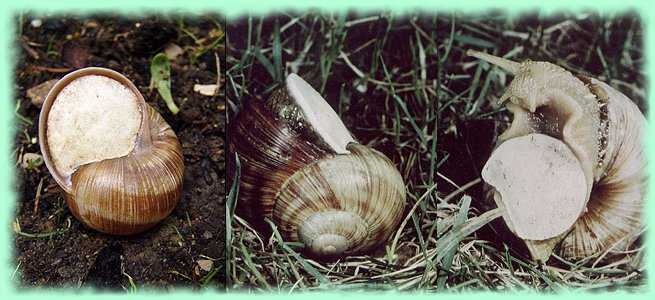 |
To protect him of the winter, Burgundy hollow a small cavity
in the ground, turns and hidden a large limestone cap called "seal."
For more than a century, we are trying, but we do not know operculer
artificially Burgundy snail. |
| Source:
weichter.de | |
According to some books, essays hibernation "deprivation" have been realized; lines have become sterile beyond 2 generations.
4 - Drying:
Before making snails hibernate, it is necessary drying they.
This stage will last for one week during which the snails bailed their intestine and make the emptiness of their water.
They can be dried either in a box, or on pallets:
In the 2 following photos, early formation of the epiphragm (left photo). He is transparent.
Right, épiphragme well trained. The latter is completely opaque.
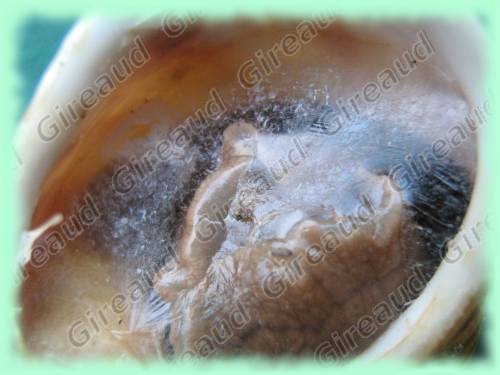 | 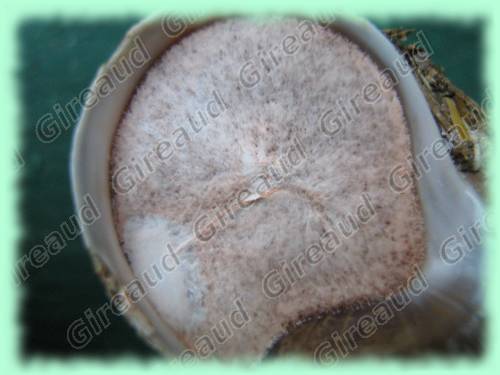 |
| Start Development of epiphragm. | Epiphragm full developed. |
| Focus on the formation of the snail epiphragm before hibernation. | 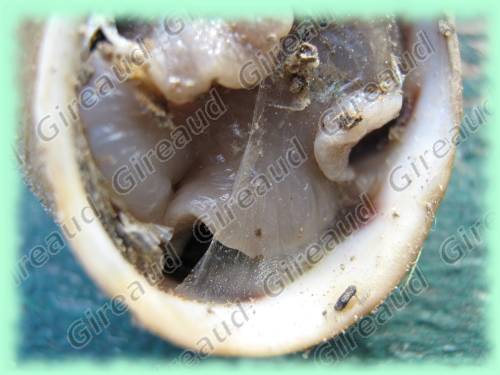 |
When the drying period is over, snails should be put into hibernation (cold room).
5 - The hibernation:
When
the number of snails is limited, the purchase of a cold room is not
profitable. I will therefore introduce other 2 cheaply methods
for hibernation : the refrigerator and leaves.
The
refrigerator:
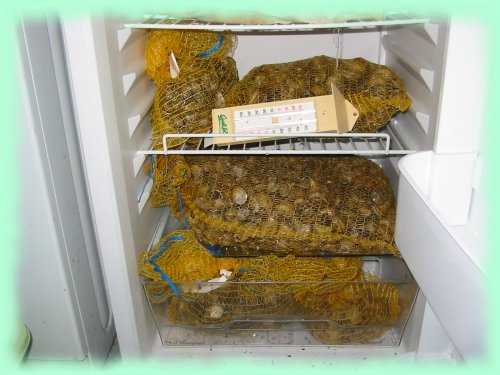 | The
refrigerator can easily replace the cold room. Il suffit de mettre les
sacs sur les étagères et de surveiller la
température qui doit être de 6° environ. Simply put
bags on the shelves and monitor (the temperature should be around 6
°). The disadvantage of this method is the need to monopolize a
fridge only for snails. Indeed, the smell of dead snail is particularly
important, so if you do not want to hear your wife screaming or
playing with the rolling pin ...........
You may use the thermometer mini-maxi to allow the well temperature.
|
Leaves:
This method will be able to use the ower of "insulation" from dried leaves.
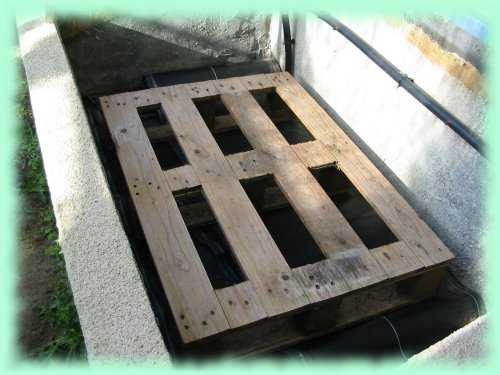 | In a escargotière, put a plastic sheet on the ground to avoid rising damp in the event of significant rainfall.
Put a wooden pallet on which to base bags snails.
If
you have only one specie of snail, it 's not necessary install a
palett, but a layer of dead leaves on which rest your snails. | Put bags on the pallet, and cover it with a good layer (20 or 30 cm) of dried and crushed leaves.
The
indispensable tool remains is the thermometer mini-maxi to be installed
at the snails level. He is the one who will tell you the temperature
gain of your "isolation" compared to the outside temperature.
Normally, you can earn 10 ° C without any problem, it depends on
the region and orientation. One of my escargotière is oriented
south, it is preferred for hibernation. | 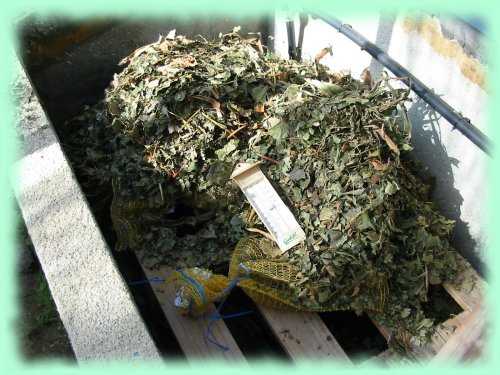 |
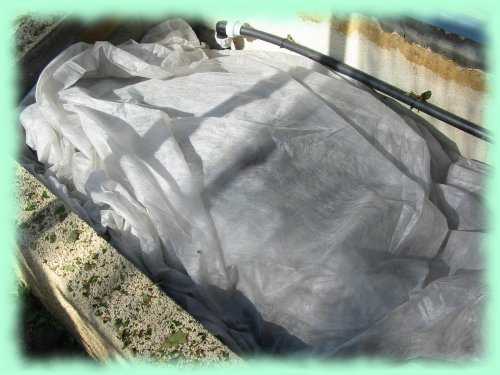 | On
the pile of leaves, install a layer or two of P17. It is a veil
for wintering plants susceptible to cold, for sale everywhere. | On the backbone of the escargotière, put a plank of wood to protect against a net overweight due to snow, cats, etc. ....
Then a plastic tarpaulin to protect it from rain.
The most important thing is to avoid moisture!.
| 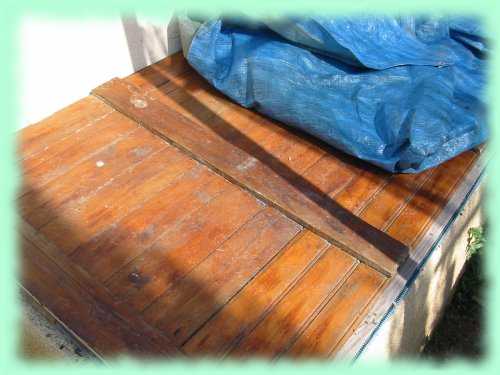 |
It is necessary to monitor weather bulletins. The
"peaks" at -15 ° C are not a danger (it took several hours before
reaching snails).
If the weather announcement is -15 or -20 °
C for a while, and your gain is 10 ° C, it will take the necessary
precautions if you do not want that your snails crystallize: P17
additional layers, blankets , etc. .....
If the cold became intense, put them in the garage waiting to milder climes (have put snails in bags is a good idea !!!).
Likewise
for the temperature too high. It's not very serious if the temperature
sometimes reaches 15 ° C during the day. They are not going to wake
up to that.
As for the system of the fridge, remember to remove the deads to avoid contaminating the whole batch.
Personnely, I use the 2 methods. That way, if an accident occurs (flood, power outage, fridge down, Siberian cold, ...), and you limit the losses.
In
early spring, if you have not put your snails in bags, you should see
them rise to the surface. It was the right time to wake them up.
Otherwise, it's up to you to get out of the bags.
6 - Losses:
Remind yourself that hibernation is a natural selection, and the snails weak and sick will not survive! And it is NORMAL !!!!!
It
is important to pass these 2 steps (drying and hibernation) in order to
limit losses. In fact, a revival of snails in the winter and then a
return to cold is fatal. I lost 5000 last year.
Les
juvéniles dont le grand diamètre de la coquille ne
dépasse pas 19 mm restent potentiellement actifs pendant la
phase hivernale et subissent une mortalité importante en
période de froid. Juveniles whose large diameter of the shell
does not exceed 19 mm still potentially active phase during the winter
and undergo a significant mortality during cold.
By the Numbers: a mortality rate of 10-15% of adults seems normal, more for the funds of park (50-80%).
To
reduce the losses of "non-lined" (fund park), the smallest (less than 1
cm) can stay in the garage in a box of hibernation, or in
mini-greenhouses. They will join the fleet in feedlots in the spring,
when frosts are no longer feared.
| | |
| |
|